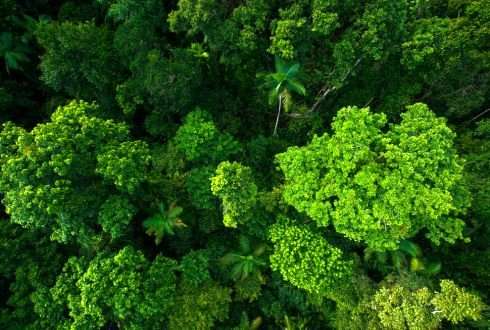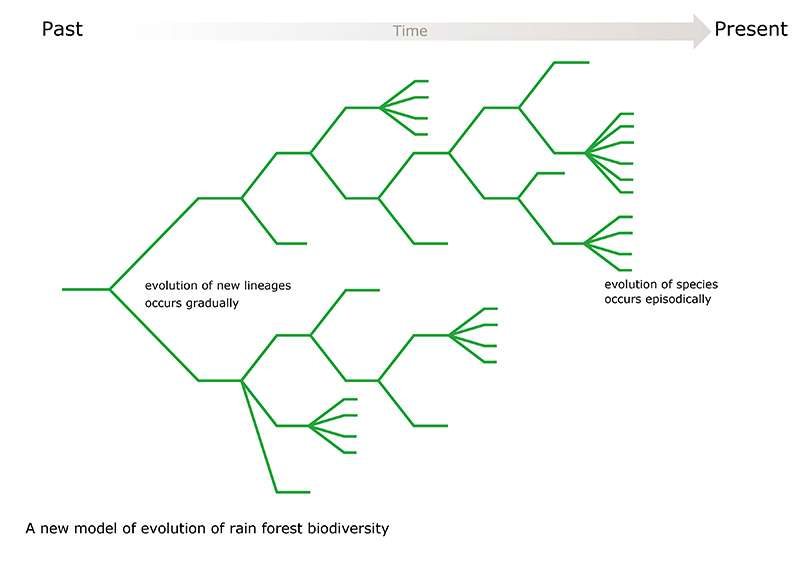Scientists propose new evolution model for tropical rainforests

Scientists from Wageningen UR and other institutes are proposing a new research model - the turnover model - as a way of answering the question why there are always so many plant species in tropical rainforests. In their publication in New Phytologist magazine, the Dutch, British and Swiss scientists show that major evolutionary changes, such as the origin of large groups of species, occur with a reasonably constant frequency while the origin of new species is an explosive process.
Various models
Darwin's contemporary Alfred Russel Wallace already argued that the Tropics are, in essence, a museum of biodiversity. As tropical climates are stable, Wallace suggested that species would gradually increase in number over longer time periods, the so-called museum model. More recently, however, it was suggested that the Pleistocene ice ages, and the impact thereof on the climate in the Tropics, resulted in recent explosions of speciation, the so-called cradle model.
Both models are supported by previous research into patterns of diversification in tropical plants. This research is performed by means of reconstructed 'phylogenetic trees'; genealogical trees that show the interrelated descent of plant species. Where analyses of plant families focused on studying as many evolutionary lines as possible from the family, diversity was shown to increase gradually. For instance, the development of diversity in important tropical plant groups such as palm trees, the leguminous family and the soursop family, appear to follow the museum model. However, within these large plant families there are also plant genera that seem to follow the cradle model: so-called radiations in which many different species developed recently and over a short period of time.
Equatiing seems impossible

Equating these two models seems an impossible task. How can a large plant family that presents an explosive increase in the number of species diversify as an entire family following the museum model? The answer lies in analysing more species per family, and better modelling speciation over long periods in evolution via the computer.
Mahogany trees
Scientists from Wageningen UR, Kew (London) and Zürich compiled the largest amount of data so far for the Meliaceae , or mahogany family. This family mainly grows in the Tropics, and is known for valuable wood such as mahogany and Spanish cedar. Parts of the nuclear and chloroplast genome of approximately 35% of the species were sequenced; a technology in which all the building blocks of the DNA are mapped.
The analysis of evolutionary diversification showed that the diversity of larger groups, such as plant genera and families, does develop in accordance with the museum model, i.e., with a certain constant frequency in the origin of new branches. The scientists showed that, in addition to this 'museum fundament', the origin of individual species is an explosive process which occurs in accordance with the cradle model.
'Young' species
The research shows that the mahogany family developed approximately 68 million years ago. The circa 200 mahogany species that grow in the South American rainforests are largely the result of two explosions in speciation (radiations) that occurred independently in two evolutionary lines in the late Miocene epoch, which was less than 10 million years ago.
An interesting aspect of this explosive origin of large numbers of species within the mahogany family is that it involves two different groups within the family which independently evolved the same ecological adaptations, such as plant height and an adaptation of seeds to the same animal species that distribute them. In addition, the two groups show a similar speed of speciation. These abrupt increases in speciation speed occurred after the mahogany family had left its original habitat (tropical dry forests and seasonal forests) and colonised the rainforests, where they were faced with different climate conditions.
New model for evolution
The results of the study show that most mahogany species in the Tropics are relatively recent. It can be assumed that this also applies to other families. The authors propose a new model, the turnover model, in which the number of evolutionary lines increases with a more or less constant speed, while speciation occurs separately and in a more explosive way.
More information: "Recently evolved diversity and convergent radiations of rainforest mahoganies (Meliaceae) shed new light on the origins of rainforest hyperdiversity." New Phytologist. doi: 10.1111/nph.13490
Journal information: New Phytologist
Provided by Wageningen University



















